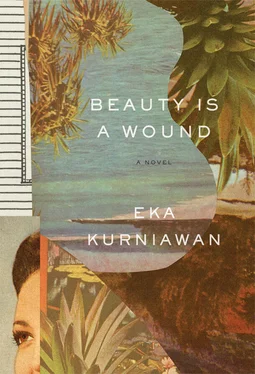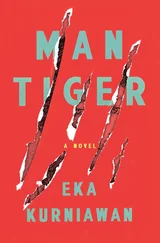It was only the natives who weren’t bothered by any of this — they still just did whatever it was they did. The cart-pullers still headed toward the port in droves, because trade kept going and the freighters kept moving. The farmers still worked their fields and the fishermen went to sea every night.
The regular soldiers arrived in the port of Halimunda, now the largest port on the whole southern coast of Java and the likely gateway for a mass evacuation to Australia. At first it had only been a regular fishing port at the large mouth of the Rengganis River, and not part of the seafaring tradition. People from the coast and from further inland gathered there to barter goods. The fishermen exchanged fish, salt, and shrimp paste for rice, vegetables, and spices.
And long before that, Halimunda had been nothing but a swath of swampy forest, a foggy area belonging to nobody. A princess from the last generation of the Pajajaran had run away to that region and given it a name. Her descendants had then developed it into villages and townships. The Mataram Kingdom banished their dissident princes there and the Dutch were originally completely uninterested in the district — the swamps threatened malaria, the flooding was uncontrollable, and the roads were in terrible condition. The first large ship to dock there came in the middle of the eighteenth century, an English ship named The Royal George , which had come only to gather fresh water, not to trade. However, this made the Dutch administration a tad irate, suspicious that the English had in fact bought coffee and indigo, and maybe pearls, and maybe were smuggling weapons through Halimunda to store in Diponegoro. So finally the first Dutch expedition arrived, to have a look around and make a map.
A lieutenant, two sergeants, two corporals, and approximately sixty armed soldiers were the first Dutch to live there, and their small garrison opened a formal post in Halimunda. That was after the war of Diponegoro had ended, when the Cultivation System started. Before this garrison, and before the Dutch started planting their own cocoa, the harvest of the coffee and indigo that grew abundantly throughout inland Halimunda had been brought via the interior road cutting across Java toward Batavia. This route presented a lot of risks: the goods might spoil on the way, and there were thieves along the road. Now that Halimunda’s garrison and seaport had opened, the harvests could be loaded directly onto ships and sent straight to Europe to be sold. Wider streets were built to accommodate the cart and wagon traffic. Canals were dug to avoid flooding, and warehouses were constructed all around the port. Even though it was never very significant compared to any of the ports in the north, Halimunda was noticed by the colonial government, and finally the port was opened to private businesses.
Of course the first business that operated in the city was Nederlandsch Indisch Stoomvaartmaatshappij , which had a number of sailing ships. Some warehousing businesses were also established, especially after the railway opened, traversing the island from east to west. As it turned out, however, trade there never really reached a golden age — instead, after establishing that first garrison, the colonial government developed Halimunda into a military stronghold. They saw a strategic opportunity; as the only big port on the southern coast, the city could act like a back door through which the Dutch could evacuate to Australia, without having to pass through the Sunda or Bali Strait, should war ever break out.
They began to build forts and install cannons on the beach to defend the port and the city. Watchtowers were built on the peaks of the hills in the jungle along the very same cape where many years ago the princess descended from the Pajajaran Kingdom had lived. One hundred artillery troops were brought in. Twenty years later, twenty-five massive Armstrong cannons were installed, and the defense plans reached their peak in the early twentieth century with the building of more military barracks. That was the start of several things in Halimunda: whorehouses, private clubs, hospitals, efforts to eradicate malaria, and the Dutch businessmen who began to spill into the city, some of whom established the cocoa plantations and stayed for many years.
When war broke out and Germany occupied Holland, all the military facilities were improved and even more soldiers were brought into the city. Then the radio announced that two English warships, The Prince of Wales and Repulse , had been sunk by Japan, and the Malay Peninsula had fallen to the enemy. The Japanese victory did not stop there. Not long after the Malay Peninsula was captured, Lieutenant General Arthur Percival, the commander of the English defense, signed the surrender of Singapore, long rumored to be the strongest British bastion. Everything was getting worse, leading up to the morning when a controller visited the houses of the Halimunda people and said something that really chilled them to the bone: “Surabaya has been bombed by Japan.” The native laborers stopped working and all trade froze. “You have to evacuate, Miss,” they said to Marietje Stammler, who along with Hanneke and Dewi Ayu said nothing in reply.
The city was quickly crowded with refugees who came by train or private cars that sprawled out beyond the city limits, filling the ditches as their owners waited in line night after night for the opportunity to board a ship. About fifty military ships came to the port to help with the evacuation. Everything was in chaos, and an East Indies defeat seemed guaranteed. After obtaining assurance as to when they could leave, the remaining members of the Stammler family hastily started to pack, but were surprised by Dewi Ayu’s sudden pronouncement: “I’m not going.”
“Don’t be foolish, child,” said Hanneke. “Japan will not just pass you by.”
“Whatever the case may be, a Stammler must stay here,” she said stubbornly. “You know as well as I do who we must wait for.”
Brought to tears by her hardheadedness, Marietje wailed, “They will make you a prisoner of war!”
“Grandma, my name is Dewi Ayu and everyone knows that’s the name of a native.”
After the Japanese battered Surabaya with their bombs, they continued toward their objective, Tanjung Priok. A number of high-ranking officials in the colonial government were the first people to evacuate. Marietje and Hanneke Stammler finally boarded the mammoth steamship Zaandam without knowing Ted’s fate on the battlefield and leaving Dewi Ayu behind, as she insisted. The ship had hauled loads of passengers back and forth many times, but this was its last voyage: the Zaandam and another ship crossed paths with a Japanese cruiser and the two were sunk without a fight. Dewi Ayu and Mr. Willie and the servants and the tough guys began their days of mourning.
A Japanese infantry from the forty-eighth division landed in Kragan after a battle in Bataan, in the Philippines. Half of them moved to Malang via Surabaya, and the other half arrived in Halimunda, naming themselves the Sakaguchi Brigade. Japanese planes were already flying in the sky and dropping bombs on Mexolie Olvado’s oil refineries belonging to Bataafse Petroleum Maatschappij, on the workmen’s housing, and on the cocoa and coconut plantation offices. The Sakaguchi Brigade had been battling with the Dutch KNIL army that was holding strong outside the city for only two days when General P. Meijer received the news that Holland had surrendered in Kalijati. All of the East Indies had been toppled and occupied. General P. Meijer surrendered control of Halimunda to Japan in City Hall.
Dewi Ayu saw and heard all of these events with her own eyes and ears, and yet during her period of mourning she didn’t speak to anyone, she just sat on the veranda behind their house, looking out at the hill that Ted had said was named after Ma Iyang. One afternoon she saw Mr. Willie appear in the backyard, accompanied by a borzoi dog that supposedly used to belong to her father, Henri. For the first time since the mourning period had begun, she spoke.
Читать дальше











